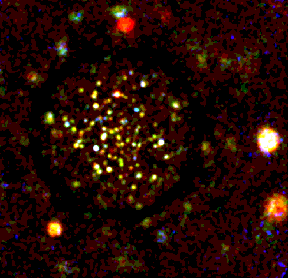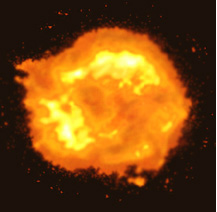Observing the High Energy universe
X-rays are a high-energy, invisible form of light. They are
produced in the cosmos when gas is heated to millions of degrees
by violent and extreme conditions. Much of the matter in the
universe is so hot that it can be observed only with X-ray
telescopes. Flaring stars, exploding stars, black holes, and
vast clouds of hot gas in galaxy clusters are among the
fascinating objects that Chandra X-ray Observatory is designed
to study.
Images from Chandra X-ray Observatory will show fifty times
more detail than any previous X-ray telescope. It is a
revolutionary telescope that combines the ability to make sharp
images while it measures precisely the energies of X-rays coming
from cosmic sources.
Stars, Supernovae & Life
How will Chandra images of young stars help
scientists better understand the evolution of life on
Earth?
On occasion, a spectacular eruption occurs in the upper
atmosphere of the Sun. These eruptions, called solar flares,
shower Earth's atmosphere with X-rays and high-energy particles.
The long term effects of solar flares on the climate and on life
on Earth is not well understood. By observing X-rays

ROSAT X-ray image of NGC 2516, a cluster
of young stars. (NASA)
|
|
from hundreds of other stars, especially young stars which flare
much more often than the Sun, astrophysicists hope to get a
better idea of what conditions were like on Earth when the Sun
was young.
What can X-ray spectra reveal about the
origin of heavy elements that are necessary for
life?
Heavy elements such as carbon, nitrogen, oxygen and iron are
made deep in the interior of massive stars. They are eventually
spread throughout space when a massive star undergoes a
catastrophic explosion called a supernova.

ROSAT X-ray image of Cassiopeia A, a
remnant of a star that exploded about 300 years ago.
(NASA)
In our galaxy a supernova occurs about every fifty years. The
shell of matter thrown off by the supernova creates a bubble of
multimillion degree gas called a supernova remnant. This hot gas
will expand and produce X-radiation for thousands of years.
Chandra X-ray Observatory images will trace the dynamics of the
expanding remnant. When heavy elements present in the hot gas
are heated to high temperatures, they produce X-rays of specific
energies. Chandra X-ray Observatory detectors will precisely
measure the energies of these X-rays and tell how much of each
element is present.
|



